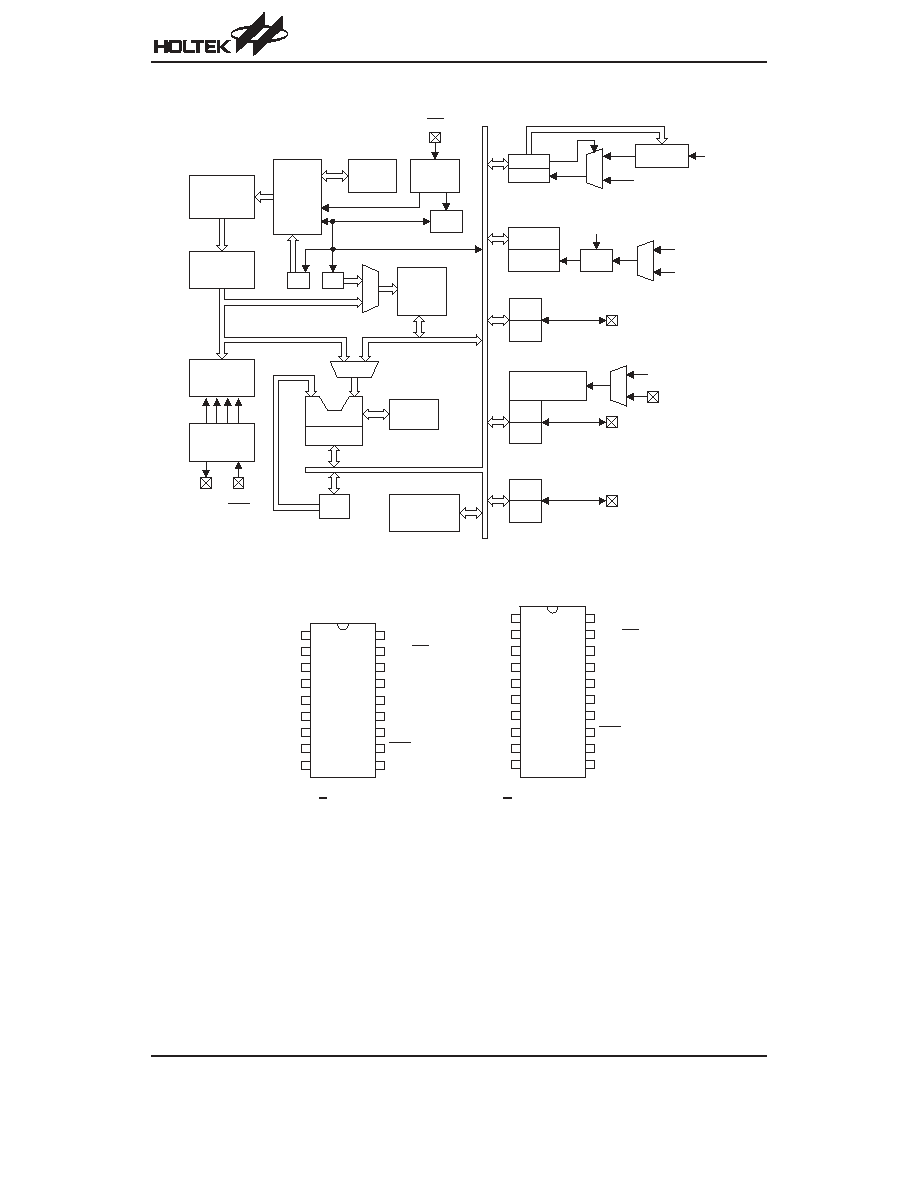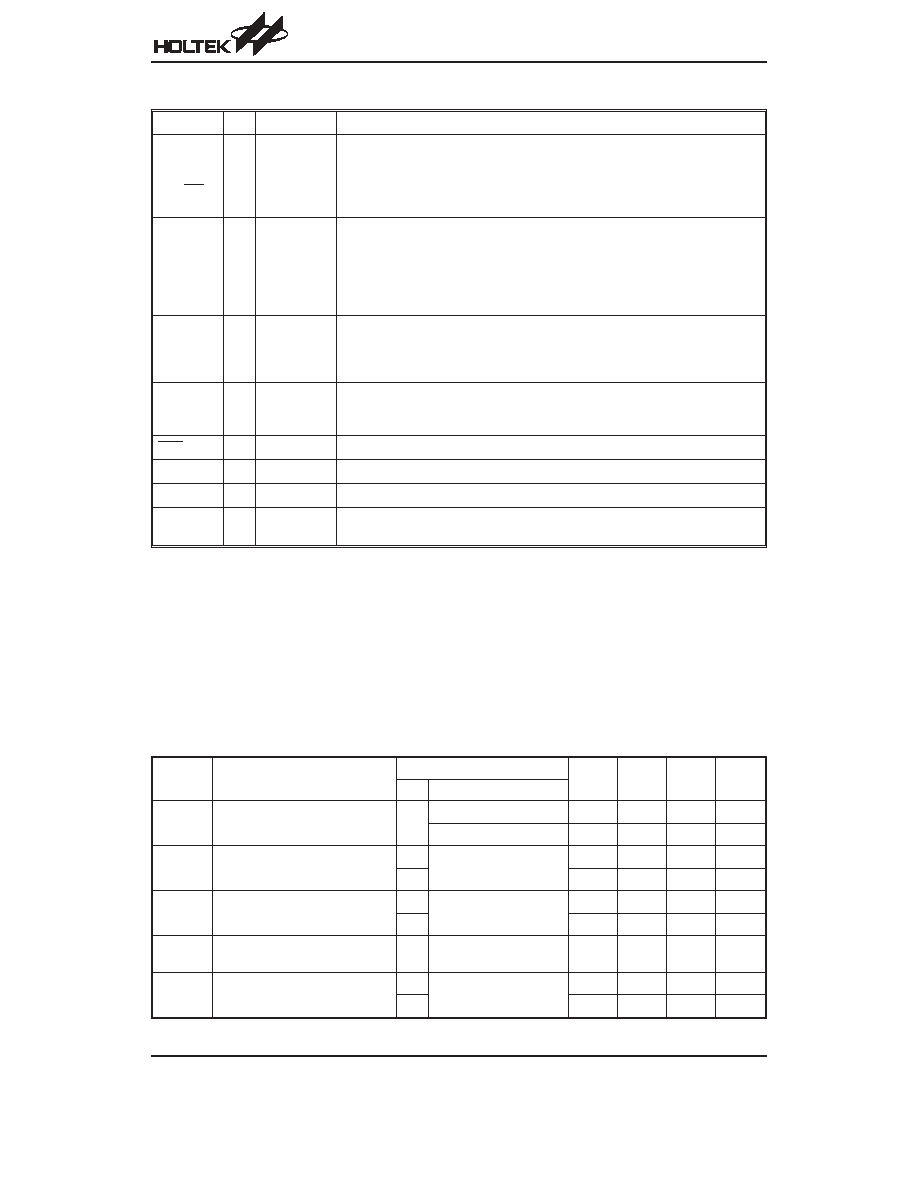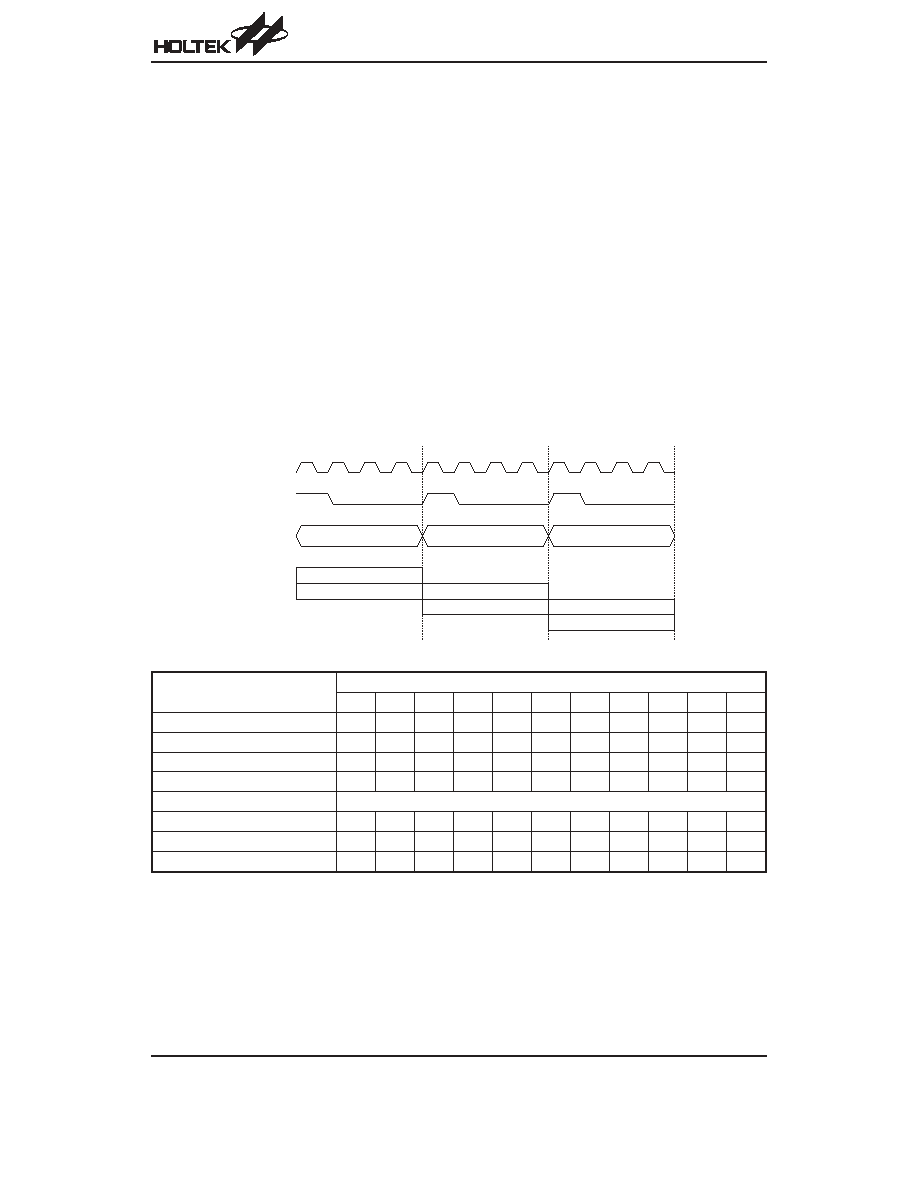 | ÐлекÑÑоннÑй компоненÑ: HT46R52 | СкаÑаÑÑ:  PDF PDF  ZIP ZIP |
Äîêóìåíòàöèÿ è îïèñàíèÿ www.docs.chipfind.ru

HT46R51/HT46R52
A/D Type 8-Bit OTP MCU
Rev. 1.40
1
July 12, 2005
General Description
The HT46R51/HT46R52 are 8-bit high performance,
RISC architecture microcontroller devices specifically
designed for A/D applications that interface directly to
analog signals, such as those from sensors. The advan-
tages of low power consumption, I/O flexibility, timer
functions, oscillator options, multi-channel A/D con-
verter, Pulse Width Modulation function, HALT and
wake-up functions, watchdog timer, as well as low cost,
enhance the versatility of these devices to suit a wide
range of A/D application possibilities such as sensor
signal processing, chargers, motor driving, industrial
control, consumer products, subsystem controllers, etc.
Features
·
Low-power fully static CMOS design
·
Operating voltage:
f
SYS
=4MHz: 2.2V~5.5V
f
SYS
=8MHz: 3.3V~5.5V
·
Program Memory:
1K
´14 OTP (HT46R51)
2K
´14 OTP (HT46R52)
·
Data memory: 88
´8 RAM
·
A/D converter: 12bits
´5Ch
External A/D converter reference voltage input pin
·
14 bidirectional I/O lines
·
1 interrupt input shared with an I/O line
·
8-bit programmable timer/event counter with over-
flow interrupt and 7-stage prescaler
·
On-chip crystal and RC oscillator
·
6-level subroutine nesting
·
Watchdog Timer
·
Low voltage reset function
·
HALT function
·
Up to 0.5
ms instruction cycle with 8MHz system clock
at V
DD
=5V
·
1-channel 8-bit PWM output shared with an I/O line
·
PFD function
·
Bit manipulation instruction
·
Table read instruction
·
63 powerful instructions
·
All instructions in one or two machine cycles
·
18-pin DIP, 20-pin SOP/SSOP package
Technical Document
·
Tools Information
·
FAQs
·
Application Note
-
HA0003E Communicating between the HT48 & HT46 Series MCUs and the HT93LC46 EEPROM
-
HA0004E HT48 & HT46 MCU UART Software Implementation Method
-
HA0084E NiMH Battery Charger Demo Board - Using the HT46R52

Block Diagram
Pin Assignment
HT46R51/HT46R52
Rev. 1.40
2
July 12, 2005
O S C 2 O S C 1
R E S
V D D
M U X
V S S
P r o g r a m
R O M
P r o g r a m
C o u n t e r
I n t e r r u p t
C i r c u i t
I N T C
D A T A
M e m o r y
I n s t r u c t i o n
R e g i s t e r
M
U
X
I n s t r u c t i o n
D e c o d e r
S T A T U S
A L U
S h i f t e r
T i m i n g
G e n e r a t o r
A C C
M P
B P
M
U
X
f
S Y S
P r e s c a l e r
T M R
T M R C
T M R
M
U
X
W D T O S C
W D T
f
S Y S
/ 4
W D T S
W D T
P r e s c a l e r
E N / D I S
P o r t A
P A
P A C
P A 0 ~ P A 2 , P A 3 / P F D
P A 4 / T M R , P A 5 / I N T
P A 6 ~ P A 7
M
U
X
V R E F
V D D
P o r t B
P B
P B C
P B 0 / A N 0 ~ P B 4 / A N 4
A / D C o n v e r t e r
P o r t D
P D
P D C
P D 0 / P W M
O p t i o n R O M
O T P O n l y
I N T
S T A C K
H T 4 6 R 5 1 / H T 4 R 5 2
1 8 D I P - A
P A 4 / T M R
P A 5 / I N T
P A 6
P A 7
O S C 2
O S C 1
V D D
R E S
P B 3 / A N 3
P A 3 / P F D
P A 2
P A 1
P A 0
P D 0 / P W M
P B 2 / A N 2
P B 1 / A N 1
P B 0 / A N 0
V S S
1 8
1 7
1 6
1 5
1 4
1 3
1 2
1 1
1 0
1
2
3
4
5
6
7
8
9
2 0
1 9
1 8
1 7
1 6
1 5
1 4
1 3
1 2
1 1
1
2
3
4
5
6
7
8
9
1 0
H T 4 6 R 5 1 / H T 4 R 5 2
2 0 S O P - A / S S O P - A
P A 4 / T M R
P A 5 / I N T
P A 6
P A 7
O S C 2
O S C 1
V D D
R E S
P B 4 / A N 4
P A 3 / P F D
P A 2
P A 1
P A 0
P D 0 / P W M
P B 2 / A N 2
P B 1 / A N 1
P B 0 / A N 0
V S S
V R E F
P B 3 / A N 3

Pin Description
Pin Name
I/O
Options
Description
PA0~PA2
PA3/PFD
PA4/TMR
PA5/INT
PA6~PA7
I/O
Pull-high
Wake-up
PA3 or PFD
Bidirectional 8-bit input/output port. Each individual bit on this port can be config-
ured as a wake-up input by configuration option. Software instructions determine
if the pin is a CMOS output or Schmitt trigger input. Configuration options deter-
mine which pins on this port have pull-high resistors. The PFD, TMR and external
interrupt input are pin-shared with PA3, PA4, and PA5 respectively.
PB0/AN0
PB1/AN1
PB2/AN2
PB3/AN3
PB4/AN4
I/O
Pull-high
Bidirectional 5-bit input/output port. Software instructions determine the CMOS
output or Schmitt trigger input with or without pull-high resistor. Configuration op-
tions determine which pins on this port have pull-high resistors. PB is pin-shared
with the A/D input pins. The A/D inputs are selected via software instructions
Once selected as an A/D input, the I/O function and pull-high resistor functions
are disabled automatically.
PD0/PWM
I/O
Pull-high
PD0 or PWM
Bidirectional 1-bit input/output port. Software instructions determine the CMOS
output or Schmitt trigger input with or without pull-high resistor. One configuration
option determines which pin on this port has pull-high resistor. PD0 is pin-shared
with the PWM output selected via configuration option.
OSC1
OSC2
I
O
Crystal or RC
OSC1, OSC2 are connected to an external RC network or external crystal (deter-
mined by configuration option) for the internal system clock. For external RC sys-
tem clock operation, OSC2 is an output pin for 1/4 system clock.
RES
I
¾
Schmitt trigger reset input, active low
VDD
¾
¾
Positive power supply
VSS
¾
¾
Negative power supply, ground
VREF
I
¾
A/D Converter Reference Input voltage pins. Connect this pin to the desired A/D
reference voltage. The VREF pin is connected to V
DD
for the 18-pin DIP package
Absolute Maximum Ratings
Supply Voltage ...........................V
SS
-0.3V to V
SS
+6.0V
Storage Temperature ............................
-50°C to 125°C
Input Voltage..............................V
SS
-0.3V to V
DD
+0.3V
Operating Temperature...........................
-40°C to 85°C
Note: These are stress ratings only. Stresses exceeding the range specified under
²Absolute Maximum Ratings² may
cause substantial damage to the device. Functional operation of this device at other conditions beyond those
listed in the specification is not implied and prolonged exposure to extreme conditions may affect device reliabil-
ity.
D.C. Characteristics
Ta=25
°C
Symbol
Parameter
Test Conditions
Min.
Typ.
Max.
Unit
V
DD
Conditions
V
DD
Operating Voltage
¾
f
SYS
=4MHz
2.2
¾
5.5
V
f
SYS
=8MHz
3.3
¾
5.5
V
I
DD1
Operating Current (Crystal OSC)
3V
No load, f
SYS
=4MHz
ADC disabled
¾
0.6
1.5
mA
5V
¾
2
4
mA
I
DD2
Operating Current (RC OSC)
3V
No load, f
SYS
=4MHz
ADC disabled
¾
0.8
1.5
mA
5V
¾
2.5
4
mA
I
DD3
Operating Current
5V
No load, f
SYS
=8MHz
ADC disabled
¾
4
8
mA
I
STB1
Standby Current (WDT Enabled)
3V
No load, system HALT
¾
¾
5
mA
5V
¾
¾
10
mA
HT46R51/HT46R52
Rev. 1.40
3
July 12, 2005

Symbol
Parameter
Test Conditions
Min.
Typ.
Max.
Unit
V
DD
Conditions
I
STB2
Standby Current
(WDT & AD Disabled)
3V
No load, system HALT
¾
¾
1
mA
5V
¾
¾
2
mA
V
IL1
Input Low Voltage for I/O Ports,
TMR and INT
¾
¾
0
¾
0.3V
DD
V
V
IH1
Input High Voltage for I/O Ports,
TMR and INT
¾
¾
0.7V
DD
¾
V
DD
V
V
IL2
Input Low Voltage (RES)
¾
¾
0
¾
0.4V
DD
V
V
IH2
Input High Voltage (RES)
¾
¾
0.9V
DD
¾
V
DD
V
V
LVR
Low Voltage Reset Voltage
¾ Configuration option: 3V
2.7
3
3.3
V
I
OL
I/O Port Sink Current
3V
V
OL
=0.1V
DD
4
8
¾
mA
5V
10
20
¾
mA
I
OH
I/O Port Source Current
3V
V
OH
=0.9V
DD
-2
-4
¾
mA
5V
-5
-10
¾
mA
R
PH
Pull-high Resistance of I/O Ports
3V
¾
20
60
100
k
W
5V
10
30
50
k
W
V
AD
A/D Input Voltage
¾
¾
0
¾
V
REF
V
V
REF
ADC Input Reference Voltage
Range
¾
¾
1.2
¾
VDD
V
DNL
ADC Differential Non-Linear
¾
¾
¾
¾
±2
LSB
INL
ADC Integral Non-Linear
¾
¾
¾
±2.5
±4
LSB
RESOLU Resolution
¾
¾
¾
¾
12
Bits
I
ADC
Additional Power Consumption
if A/D Converter is Used
3V
¾
¾
0.5
1
mA
5V
¾
1.5
3
mA
A.C. Characteristics
Ta=25
°C
Symbol
Parameter
Test Conditions
Min.
Typ.
Max.
Unit
V
DD
Conditions
f
SYS
System Clock (Crystal OSC)
¾ 2.2V~5.5V
400
¾
4000
kHz
¾ 3.3V~5.5V
400
¾
8000
kHz
f
TIMER
Timer I/P Frequency (TMR)
¾ 2.2V~5.5V
0
¾
4000
kHz
¾ 3.3V~5.5V
0
¾
8000
kHz
t
WDTOSC
Watchdog Oscillator Period
3V
¾
45
90
180
ms
5V
¾
32
65
130
ms
t
RES
External Reset Low Pulse Width
¾
¾
1
¾
¾
ms
t
SST
System Start-up Timer Period
¾ Wake-up from HALT
¾
1024
¾
t
SYS
t
INT
Interrupt Pulse Width
¾
¾
1
¾
¾
ms
t
AD
A/D Clock Period
¾
¾
1
¾
¾
ms
t
ADC
A/D Conversion Time
¾
¾
¾
80
¾
t
AD
t
ADCS
A/D Sampling Time
¾
¾
¾
32
¾
t
AD
Note: t
SYS
=1/f
SYS
HT46R51/HT46R52
Rev. 1.40
4
July 12, 2005

HT46R51/HT46R52
Rev. 1.40
5
July 12, 2005
Functional Description
Execution Flow
The system clock for the microcontroller is derived from
either a crystal or an RC oscillator. The system clock is
internally divided into four non-overlapping clocks. One
instruction cycle consists of 4 system clock cycles.
Instruction fetching and execution are pipelined in such
a way that a fetch and decoding takes an instruction cy-
cle while execution take the next instruction cycle. The
pipelining scheme causes each instruction to effectively
execute in a cycle. If an instruction changes the program
counter, two cycles are required to complete the instruc-
tion.
Program Counter
- PC
For HT46R51, the program counter (PC) is 10 bits wide
and controls the sequence in which the instructions
stored in the program ROM are executed. The contents
of the PC can specify a maximum of 1024 addresses.
For HT46R52, the program counter (PC) is 11 bits wide
and controls the sequence in which the instructions
stored in the program ROM are executed. The contents
of the PC can specify a maximum of 2048 addresses.
After accessing a program memory word to fetch an in-
struction code, the contents of the program counter are
incremented by one. The program counter then points to
the memory word containing the next instruction code.
When executing a jump instruction, conditional skip ex-
ecution, loading register, subroutine call or return from
subroutine, initial reset, internal interrupt, external inter-
rupt or return from interrupts, the PC manipulates the
program transfer by loading the address corresponding
to each instruction.
The conditional skip is activated by instructions. Once
the condition is met, the next instruction, fetched during
the current instruction execution, is discarded and a
dummy cycle replaces it to get the proper instruction.
Otherwise proceed to the next instruction.
T 1
T 2
T 3
T 4
T 1
T 2
T 3
T 4
T 1
T 2
T 3
T 4
F e t c h I N S T ( P C )
E x e c u t e I N S T ( P C - 1 )
F e t c h I N S T ( P C + 1 )
E x e c u t e I N S T ( P C )
F e t c h I N S T ( P C + 2 )
E x e c u t e I N S T ( P C + 1 )
P C
P C + 1
P C + 2
S y s t e m C l o c k
O S C 2 ( R C o n l y )
P C
Execution Flow
Mode
Program Counter
*b10
*b9
*b8
*b7
*b6
*b5
*b4
*b3
*b2
*b1
*b0
Initial Reset
0
0
0
0
0
0
0
0
0
0
0
External Interrupt
0
0
0
0
0
0
0
0
1
0
0
Timer/Event Counter Overflow
0
0
0
0
0
0
0
1
0
0
0
A/D Converter Interrupt
0
0
0
0
0
0
0
1
1
0
0
Skip
Program Counter+2
Loading PCL
PC10
PC9
PC8
@7
@6
@5
@4
@3
@2
@1
@0
Jump, Call Branch
#10
#9
#8
#7
#6
#5
#4
#3
#2
#1
#0
Return from Subroutine
S10
S9
S8
S7
S6
S5
S4
S3
S2
S1
S0
Program Counter
Note:
*b10~*b0: Program counter bits
S10~S0: Stack register bits
#10~#0: Instruction code bits
@7~@0: PCL bits, PC10~PC8: Original PC counter, remain unchanged
For the HT46R51, since the program counter is 10 bits wide (b0~b9), the b10 columns in the table are not ap-
plicable.
For the HT46R52, since the program counter is 11 bits wide (b0~b10)
Document Outline
- þÿ
- þÿ
- þÿ
- þÿ
- þÿ
- þÿ
- þÿ
- þÿ
- þÿ
- þÿ
- þÿ
- þÿ
- þÿ
- þÿ
- þÿ




